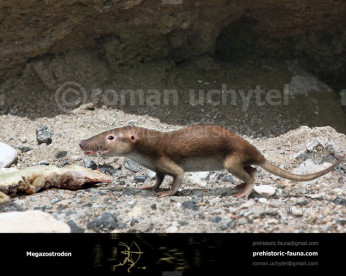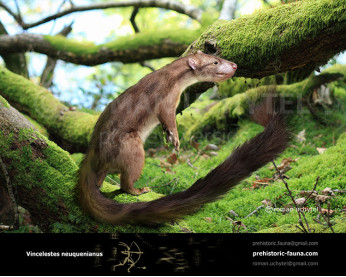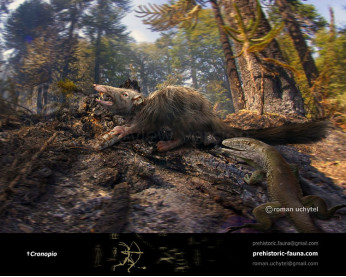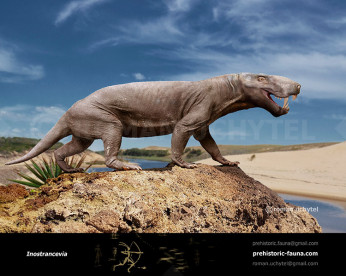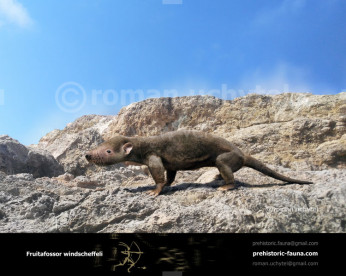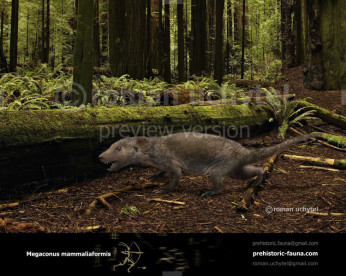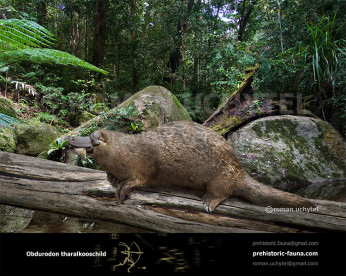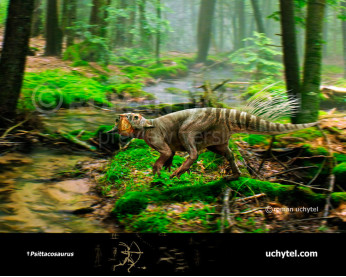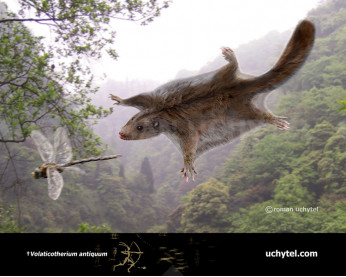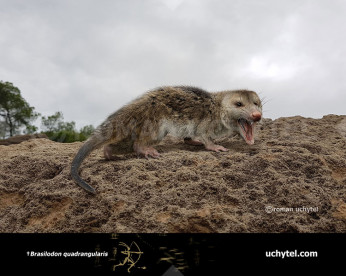Repenomamus
1000000001710000000017
Repenomamus (†Repenomamus (Li et al., 2000))
Kingdom: Animalia
Class: Mammalia
Clade: †Eutriconodonta (?)
Family: †Gobiconodontidae
Temporal range: Cretaceous, 125–123.2 Ma (China)
Dimensions: length - 1 m, height - 25 сm, weight - 4-14 kg
Type species: †Repenomamus robustus
Repenomamus is a genus of opossum- to badger-sized gobiconodontid mammal. Repenomamus robustus and Repenomamus giganticus are known from fossils found in China that date to the early Cretaceous period, about 125-123.2 million years ago. R. robustus is one of several Mesozoic mammals for which there is good evidence that it fed on vertebrates, including dinosaurs. Though it is not entirely clear whether or not these animals primarily hunted live dinosaurs or scavenged dead ones, evidence for the former is present in fossilized remains showcasing the results of what was most likely a predation attempt by R. robustus directed at a specimen of the dinosaur Psittacosaurus lujiatunensis. R. giganticus is among the largest mammals known from the Mesozoic era. Only Kollikodon may be larger, and Schowalteria, Oxlestes, Khuduklestes and Bubodens reached similar if not larger sizes.
Repenomamus is a genus of triconodonts, a group of early mammals with no modern relatives. R. robustus was described by Li, Wang, Wang and Li in 2000, and R. giganticus was described by Hu, Meng, Wang and Li in 2005. The two known species are the sole members of the family Repenomamidae, which was also described in the same paper in 2000. It is sometimes alternatively listed as a member of the family Gobiconodontidae; although this assignment is controversial, a close relationship to this family is well-founded.
Adults of R. robustus were the size of a Virginia opossum. Estimated mass of R. robustus is 4–6 kg. The known adult of R. giganticus was about 50% larger than R. robustus, with a body length of 68.2 cm and total length over 1 m and an estimated mass of 12–14 kg. Features of its shoulder and legs bones indicate a sprawling posture as in most of small to medium sized living therian mammals, with plantigrade feet. Unlike therian mammals, Repenomamus had a proportionally longer body with shorter limbs.
More evidence suggesting Repenomamus was suited to a predatory lifestyle was later revealed when a specimen of R. robustus was uncovered alongside an adult Psittacosaurus. The intertwined nature of the fossil, similar to the Fighting Dinosaurs fossil of Mongolia, was likely a byproduct of an altercation between the two animals in which the mammal was most likely the instigator of an ongoing predation attempt. This was posited on the basis that the Repenomamus involved was noted to have been latching on to the Psittacosaurus with its arms and legs while biting the dinosaur.
Like most other non-placental mammals, Repenomamus had epipubic bones, implying that it gave birth to undeveloped young, or laid eggs like modern marsupials and monotremes.
Оплата
У Вас є кілька зручних способів купівлі зображення: кредитна чи дебетова картка Visa, Mastercard, Maestro; PayPal або банківський переказ
Repenomamus (†Repenomamus (Li et al., 2000))
Kingdom: Animalia
Class: Mammalia
Clade: †Eutriconodonta (?)
Family: †Gobiconodontidae
Temporal range: Cretaceous, 125–123.2 Ma (China)
Dimensions: length - 1 m, height - 25 сm, weight - 4-14 kg
Type species: †Repenomamus robustus
Repenomamus is a genus of opossum- to badger-sized gobiconodontid mammal. Repenomamus robustus and Repenomamus giganticus are known from fossils found in China that date to the early Cretaceous period, about 125-123.2 million years ago. R. robustus is one of several Mesozoic mammals for which there is good evidence that it fed on vertebrates, including dinosaurs. Though it is not entirely clear whether or not these animals primarily hunted live dinosaurs or scavenged dead ones, evidence for the former is present in fossilized remains showcasing the results of what was most likely a predation attempt by R. robustus directed at a specimen of the dinosaur Psittacosaurus lujiatunensis. R. giganticus is among the largest mammals known from the Mesozoic era. Only Kollikodon may be larger, and Schowalteria, Oxlestes, Khuduklestes and Bubodens reached similar if not larger sizes.
Repenomamus is a genus of triconodonts, a group of early mammals with no modern relatives. R. robustus was described by Li, Wang, Wang and Li in 2000, and R. giganticus was described by Hu, Meng, Wang and Li in 2005. The two known species are the sole members of the family Repenomamidae, which was also described in the same paper in 2000. It is sometimes alternatively listed as a member of the family Gobiconodontidae; although this assignment is controversial, a close relationship to this family is well-founded.
Adults of R. robustus were the size of a Virginia opossum. Estimated mass of R. robustus is 4–6 kg. The known adult of R. giganticus was about 50% larger than R. robustus, with a body length of 68.2 cm and total length over 1 m and an estimated mass of 12–14 kg. Features of its shoulder and legs bones indicate a sprawling posture as in most of small to medium sized living therian mammals, with plantigrade feet. Unlike therian mammals, Repenomamus had a proportionally longer body with shorter limbs.
More evidence suggesting Repenomamus was suited to a predatory lifestyle was later revealed when a specimen of R. robustus was uncovered alongside an adult Psittacosaurus. The intertwined nature of the fossil, similar to the Fighting Dinosaurs fossil of Mongolia, was likely a byproduct of an altercation between the two animals in which the mammal was most likely the instigator of an ongoing predation attempt. This was posited on the basis that the Repenomamus involved was noted to have been latching on to the Psittacosaurus with its arms and legs while biting the dinosaur.
Like most other non-placental mammals, Repenomamus had epipubic bones, implying that it gave birth to undeveloped young, or laid eggs like modern marsupials and monotremes.

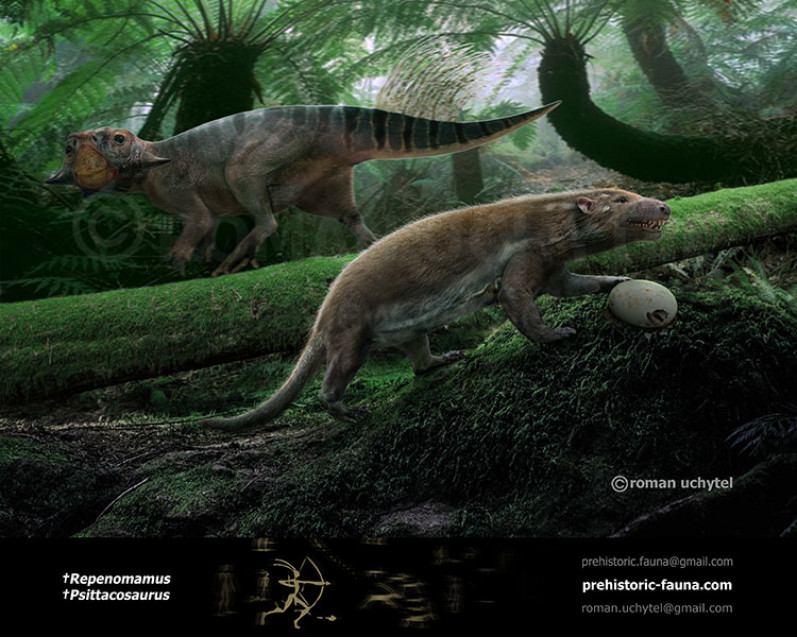
-797x638.jpg)
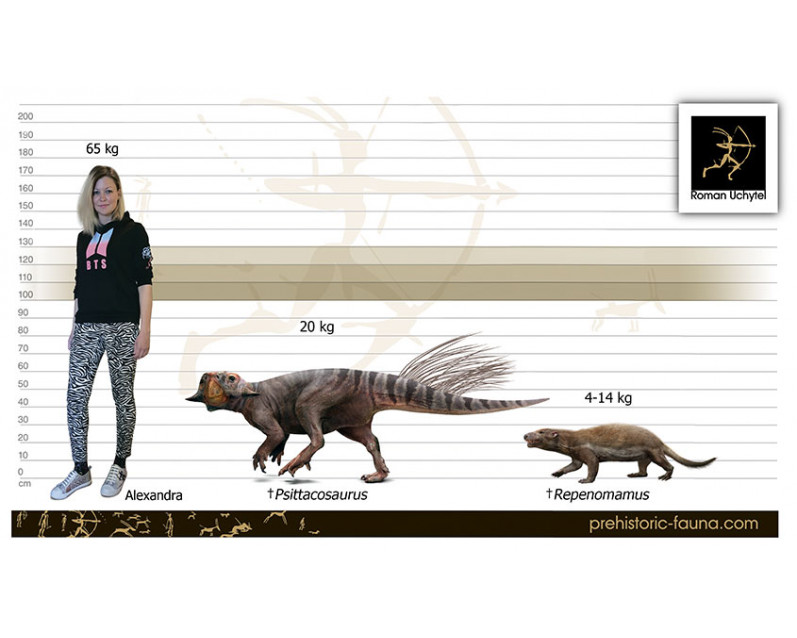

-70x56.jpg)

